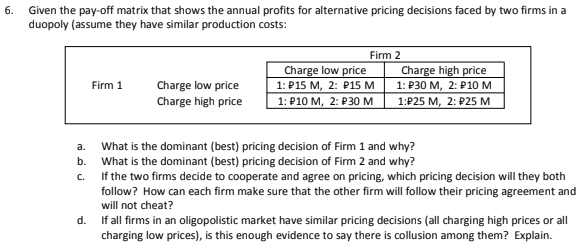6. Given the pay-off matrix that shows the annual profits for alternative pricing decisions faced by two firms in a duopoly (assume they have similar production costs: Firm 2 Firm 1 Charge low price Charge high price Charge low price 1: P15 M, 2: P15 M 1: P10 M, 2: P30 M Charge high price 1: P30 M, 2: P10 M 1:P25 M, 2: P25 M a. What is the dominant (best) pricing decision of Firm 1 and why? b. What is the dominant (best) pricing decision of Firm 2 and why? C. If the two firms decide to cooperate and agree on pricing, which pricing decision will they both follow? How c ich firm make sure that the other firm will follow their pricing P
6. Given the pay-off matrix that shows the annual profits for alternative pricing decisions faced by two firms in a duopoly (assume they have similar production costs: Firm 2 Firm 1 Charge low price Charge high price Charge low price 1: P15 M, 2: P15 M 1: P10 M, 2: P30 M Charge high price 1: P30 M, 2: P10 M 1:P25 M, 2: P25 M a. What is the dominant (best) pricing decision of Firm 1 and why? b. What is the dominant (best) pricing decision of Firm 2 and why? C. If the two firms decide to cooperate and agree on pricing, which pricing decision will they both follow? How c ich firm make sure that the other firm will follow their pricing P
Principles of Economics 2e
2nd Edition
ISBN:9781947172364
Author:Steven A. Greenlaw; David Shapiro
Publisher:Steven A. Greenlaw; David Shapiro
Chapter10: Monopolistic Competition And Oligopoly
Section: Chapter Questions
Problem 3SCQ: Consider the curve in the figure below, which shows the market demand. marginal cost, and marginal...
Related questions
Question
6.

Transcribed Image Text:6.
Given the pay-off matrix that shows the annual profits for alternative pricing decisions faced by two firms in a
duopoly (assume they have similar production costs:
Firm 2
Firm 1
Charge low price
Charge high price
Charge low price
1: P15 M, 2: P15 M
1: P10 M, 2: P30 M
Charge high price
1: P30 M, 2: P10 M
1:P25 M, 2: P25 M
a.
What is the dominant (best) pricing decision of Firm 1 and why?
What is the dominant (best) pricing decision of Firm 2 and why?
b.
C.
If the two firms decide to cooperate and agree on pricing, which pricing decision will they both
follow? How can each firm make sure that the other firm will follow their pricing agreement and
will not cheat?
d. If all firms in an oligopolistic market have similar pricing decisions (all charging high prices or all
charging low prices), is this enough evidence to say there is collusion among them? Explain.
Expert Solution
This question has been solved!
Explore an expertly crafted, step-by-step solution for a thorough understanding of key concepts.
Step by step
Solved in 3 steps with 3 images

Follow-up Questions
Read through expert solutions to related follow-up questions below.
Follow-up Question
answer the last subquestion please:
d. If all firms in an oligopolistic market have similar
Solution
Knowledge Booster
Learn more about
Need a deep-dive on the concept behind this application? Look no further. Learn more about this topic, economics and related others by exploring similar questions and additional content below.Recommended textbooks for you

Principles of Economics 2e
Economics
ISBN:
9781947172364
Author:
Steven A. Greenlaw; David Shapiro
Publisher:
OpenStax

Principles of Microeconomics (MindTap Course List)
Economics
ISBN:
9781305971493
Author:
N. Gregory Mankiw
Publisher:
Cengage Learning

Managerial Economics: Applications, Strategies an…
Economics
ISBN:
9781305506381
Author:
James R. McGuigan, R. Charles Moyer, Frederick H.deB. Harris
Publisher:
Cengage Learning

Principles of Economics 2e
Economics
ISBN:
9781947172364
Author:
Steven A. Greenlaw; David Shapiro
Publisher:
OpenStax

Principles of Microeconomics (MindTap Course List)
Economics
ISBN:
9781305971493
Author:
N. Gregory Mankiw
Publisher:
Cengage Learning

Managerial Economics: Applications, Strategies an…
Economics
ISBN:
9781305506381
Author:
James R. McGuigan, R. Charles Moyer, Frederick H.deB. Harris
Publisher:
Cengage Learning